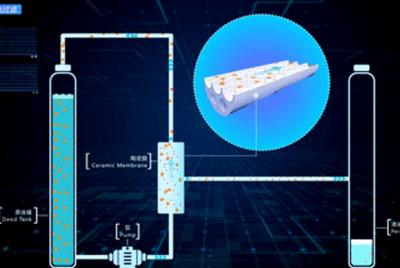Nanofiltration membrane is a new type of separation membrane that was developed in the late 1980s. Its molecular weight cut-off is between that of RO membrane and ultrafiltration membrane, typically between 100-2000Da. It is speculated that nanofiltration membrane has a pore structure of about 1nm, hence its name. Most nanofiltration membranes are composite membranes, with a surface separation layer composed of polyelectrolytes, giving them a certain retention rate for inorganic salts. Most nanofiltration membranes currently on the market are composite membranes with a layer of ultrathin separation layer with a nanometer-sized pore diameter, formed using interfacial polymerization and condensation methods on a microporous support membrane.
RO membrane is currently the most refined filtration technology. It can block all dissolved inorganic and organic molecules with relative molecular weights greater than 100, and allow water molecules to pass through to become pure water. The removal rate of divalent ions in water is high, up to 99.5%, while the removal rate for monovalent ions is also more than 95%.
RO membrane is widely used for the preparation of space water, pure water, and ultrapure water; concentration, separation, purification and pure water preparation in chemical processes; desalination of seawater and brackish water; water purification and recycling in industries such as papermaking, electroplating, and printing and dyeing.
Nanofiltration membrane separation technology can be applied to the softening of water quality, reducing TDS concentration, removing color and organic matter. Its larger application area is the softening of drinking water and the removal of organic matter. With the increasing severity of water pollution, people are paying more and more attention to the quality of drinking water.
The traditional processing of drinking water mainly uses coagulation, settling, sand filtration and chlorine disinfection to remove suspended solids and bacteria in water, but the removal effect on various dissolved chemicals is low. With the increasingly severe shortage of water resources, worsening environmental pollution, and the improvement of drinking water standards in various countries, the "deep water treatment technology for removing various organic and harmful chemicals" that can remove various organic matter and harmful chemicals is receiving more attention.
In addition, the use of nanofiltration technology can purify and concentrate biochemical reagents; separate oil and water; recover ethylene glycol; recover copper sulfate; separate and concentrate organic and inorganic liquids; purify, concentrate, and desalt dyes; separate and concentrate traditional Chinese medicine; concentrate fermentation broth. As a new type of separation membrane, nanofiltration membrane has been widely used for its excellent separation performance, and will play a driving role in reducing energy consumption, environmental protection, process optimization, and economic development.




 +86-25-58849045
+86-25-58849045
 +86-25-58749295
+86-25-58749295
 jiuwu@jiuwu.com
jiuwu@jiuwu.com
 No. 9 Park Road, Pukou District, Nanjing City (Sanqiao Factory)
No. 9 Park Road, Pukou District, Nanjing City (Sanqiao Factory) Call us on:
Call us on:  Email Us:
Email Us:  No. 9 Park Road, Pukou District, Nanjing City (Sanqiao Factory)
No. 9 Park Road, Pukou District, Nanjing City (Sanqiao Factory)

 English
English 한국어
한국어 français
français русский
русский Español
Español

